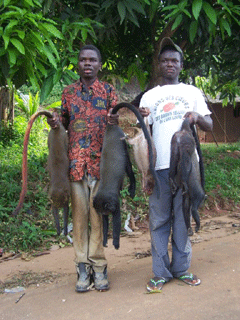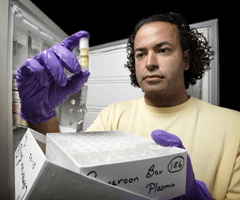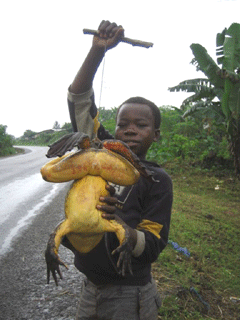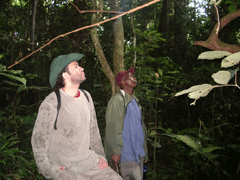Hunting for the Next Pandemic
Air Date: Week of May 18, 2007

(Courtesy of UCLA School of Public Health/Dr. Nathan Wolfe)
Many of the major human infectious diseases - such as HIV, the plague and cholera - got their start as diseases in animals. Understanding how these microbes and viruses make the leap from animals to humans could give scientists a leg up in finding the next big pandemic before it hits. Nathan Wolfe, an epidemiologist from UCLA, talks to host Bruce Gellerman about hunting for viruses in the jungles of Cameroon.
Transcript
GELLERMAN: It’s Living on Earth. I’m Bruce Gellerman. Many of the deadly infectious diseases that plague people - first infected animals. The Bubonic Plague came from infected rats the Spanish Flu pandemic came from birds and scientists have tracked HIV, the AIDS causing virus, to chimpanzees.
Still, researchers don't know precisely how viruses jump from one species to another or what triggers a viral disease to spread like wildfire. One of the scientists searching for answers is Nathan Wolfe. A biologist at UCLA, Dr. Wolfe calls himself a Virus Hunter. We hunted him down at his home in Venice, California, but much of the time you'll find him in some far-flung place trying to prevent the next pandemic by detecting viruses before they make the leap from animal to people.
Hi Dr. Wolfe.
WOLFE: Ah, Hello.
GELLERMAN: How are you?
WOLFE: I’m doing ok. I have a bit of a cold. Virus probably, one of the many viruses on the planet that we actually probably won’t ever identify.
GELLERMAN: Why not? I mean what would you do to identify this virus?
WOLFE: Well certainly one of the questions for us is, is a virus worth identifying? One of the really amazing things about being a biologist right around now is we have the tools to understand viruses and to identify them yet there are so many amazing things that are completely unknown. The world is absolutely filled with viruses so as we sort of start we have to kind of think about which ones are we going to bother to identify. And frankly my cold virus is not amongst them.

Dr. Nathan Wolfe (Courtesy of UCLA School of Public Health/Dr. Nathan Wolfe)
WOLFE: Oh, absolutely. Um, and of course one of the major objectives of my research is to try to identify what could lead to future pandemics. And instead of waiting for something like HIV to spread around the world in a way that’s going to be very very difficult to manage that we could actually try to understand these agents before they become major diseases. So if you kind of think of this process as a kind of process of a whole range of different viruses and other agents which are present in animals and then human beings, who we have our own diseases and we also have the potential to gain new diseases whether it be SARS or Ebola or HIV.
You know, you name it these are all things that are new, but the question is how do you catch that in the process? How do you actually watch one of these viruses jump from one species to the next species, and particularly from a species of animal into humans. And our idea is that we can actually try to catch this portal or bridge by focusing on people who have a lot of contact with animals. And that may be people who are working in markets where they sell live wild animals.
.gif)
Hunted Straw-coloured Fruit Bats (Eidolon helvum) are smoked and then sold for use in various dished in Southwest Province, Cameroon.(Courtesy of UCLA School of Public Health/Dr. Nathan Wolfe)
It may be individuals who are hunting or butchering wild animals. But whenever you have this sort of hunting and contact you’re going to have tremendous potential for transmition of agents in all different sorts of tissue. So we really think it’s a very important interface for the entry of new diseases into humans.
GELLERMAN: Well, how does that happen? How does a virus say start in a pig or a snake and then jump to a person?
WOLFE: Very honestly part of that is what we’re still studying and trying to determine but um often, you know, our vision in the states or the west of a hunter might be someone who’s decked out in army fatigues or wearing an orange vest but in most parts of the world where people are hunting for subsistence, you can, often hunters that we go out with will be wearing flip flops and a pair of shorts. They’ll be butchering with a machete.

A boy selling a frog to be eaten. Conraua goliath, this species is known to be the largest frog in the world. It is only found in Cameroon and mainland Equatorial Guinea(Courtesy of UCLA School of Public Health/Dr. Nathan Wolfe)
GELLERMAN: You spent six years studying hunters in Cameroon. Um, what did you find?

Dr. Wolfe in Cameroon (Courtesy of UCLA School of Public Health/Dr. Nathan Wolfe)
GELLERMAN: What was the name of the one that you found?
WOLFE: Well, we found a couple. Um, one of the viruses we found was pretty much unknown in humans other than in a few cases that were seen in people working in sort of laboratory situations but this is a virus called the simian foamy virus. And frankly it was quite a surprise I remember actually the moment in the laboratory when I was doing the tests and came across the definitive evidence that these viruses were, were in our hunters. And it really was an unusual and surprising discovery. I myself really didn’t expect to see it. I thought if it occurred it was quite rare but in fact we find that these viruses are probably in thousands, if not tens of thousands or more individuals who have close contact with, in this case particularly primates, monkeys and apes.

(Courtesy of UCLA School of Public Health/Dr. Nathan Wolfe)
WOLFE: Well, we don’t know about that yet. Retroviruses like HIV and HTLV which are the two really known important retroviruses in humans, they actually are chronic viruses. So unlike, for example Ebola, or flu or SARS, which make you sick and either you die or you get better, these are viruses which take a long time to make individuals sick. And for the foamy virus we’re actually out there right now working with these individuals who you know, generously contribute their time to participate in these studies to understand do these viruses spread? Do they cause disease? But we’re still really just at the beginning of the process of understanding what the importance of these agents is. But of course that’s the big idea. You discover it early and then you try to trace through what’s going on with the agent to see what’s happening with that.
.gif)
(Courtesy of UCLA School of Public Health/Dr. Nathan Wolfe)
WOLFE: Yes, absolutely.
GELLERMAN: So, how do you get them to trust you?
WOLFE: Well, we have long, I mean, we’ve been working in Cameroon now since 1998, 99. And what we have is we have long-term interactions in the villages we work in. For example through assistance with the US embassy in Cameroon and other sources we’ve been able to actually build in some of these communities health and conservation outreach centers. So we have a long-term interaction with these locations but I think it’s very important. You can imagine in any community that anybody’s living in somebody knocks on your door and starts saying, “oh, we’d like to talk to you about various activities and we’d like to sample your blood.” This is something which is a long-term process and to do it properly you really need to have a tremendous amount of buy in from the leadership within the village and from the individual hunters.
GELLERMAN: Is there some responsibility to them though, an ethical responsibility? Not just to follow them but perhaps treat them medically?
WOLFE: Oh, absolutely and we provide really a substantial amount of medical care for populations we work in. Now in the case of foamy virus we still haven’t determined if there’s a disease caused by foamy virus so there really isn’t any treatment to do. But um there’s a tremendous amount of counseling as to potential transmission. And ah, you know, so we spend a lot of time sort of dealing with people who are in these communities.
GELLERMAN: So, Nathan Wolfe how many potential pandemics are there waiting to happen?
WOLFE: Oh, well let’s just say there’ll be plenty of business for myself and people doing my line of work for many years to come. Things are changing. We’re becoming more urban increasingly. We have phenomenal globalization, which has all sorts of benefits but also has the fact that a virus that emerges somewhere in the middle of Central Africa today can be in Seattle, Washington tomorrow. So the level of connection between us and the animals around us and the sorts of populations and transport which allows these things to become established is changing very quickly. There do seem to be patterns about where these diseases come from. And so that just in the same way that we need to push forward the forecasting of weather, we try to understand what are the patterns of earthquakes and hurricanes. Just like that disease pandemics are a form of natural disaster and there’s no reason at all why we shouldn’t be moving these things forward and at least attempting to come up with predictive systems and forecasting systems. In a hundred years when people look back at this period of history they’re going to be saying, “Wow they really cared about these diseases. They really were trying to control them but they might have really been missing the boat they really waited for these things to become major pandemics. They didn’t try to understand the nature of them and try to control them early on before that happened.”
GELLERMAN: Well, Dr. Wolfe it was good speaking to you.
WOLFE: It was really nice speaking to you. Thank you very much.
GELLERMAN: UCLA biologist and virus hunter Nathan Wolfe is the lead author of the article "Origins of the Major Human Infectious Diseases." It’s in the current issue of Nature magazine.
[MUSIC: “The Fifth Plague” from ‘Plague Songs’ (4AD – 2006)]
Links
Living on Earth wants to hear from you!
Living on Earth
62 Calef Highway, Suite 212
Lee, NH 03861
Telephone: 617-287-4121
E-mail: comments@loe.org
Newsletter [Click here]
Donate to Living on Earth!
Living on Earth is an independent media program and relies entirely on contributions from listeners and institutions supporting public service. Please donate now to preserve an independent environmental voice.
NewsletterLiving on Earth offers a weekly delivery of the show's rundown to your mailbox. Sign up for our newsletter today!
 Sailors For The Sea: Be the change you want to sea.
Sailors For The Sea: Be the change you want to sea.
 The Grantham Foundation for the Protection of the Environment: Committed to protecting and improving the health of the global environment.
The Grantham Foundation for the Protection of the Environment: Committed to protecting and improving the health of the global environment.
 Contribute to Living on Earth and receive, as our gift to you, an archival print of one of Mark Seth Lender's extraordinary wildlife photographs. Follow the link to see Mark's current collection of photographs.
Contribute to Living on Earth and receive, as our gift to you, an archival print of one of Mark Seth Lender's extraordinary wildlife photographs. Follow the link to see Mark's current collection of photographs.
 Buy a signed copy of Mark Seth Lender's book Smeagull the Seagull & support Living on Earth
Buy a signed copy of Mark Seth Lender's book Smeagull the Seagull & support Living on Earth

